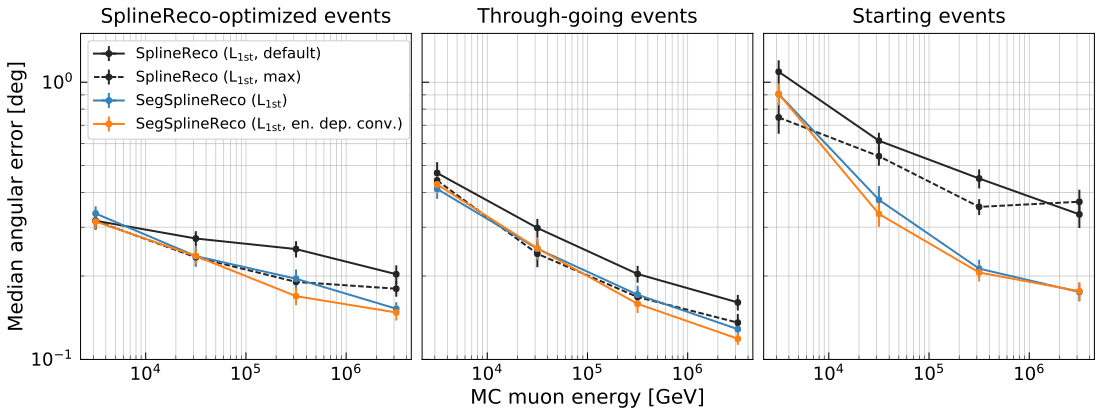When the IceCube Neutrino Observatory sees a high-energy neutrino from outer space, IceCube researchers want to know where it came from. The unconventional “telescope” uses a three-dimensional grid of supersensitive light sensors buried under the ice at the South Pole to detect signals from these tiny, nearly massless fundamental particles, which rarely interact and can travel extreme distances in a straight line. It can do this by detecting the charged particles, like muons, that are created when a neutrino interacts with an atom in the ice.
Researchers in the IceCube Collaboration are able to use data from muons to reconstruct the path that the original neutrino was traveling and point back to where it came from in the sky. However, the current best-performing program for muon track directional reconstruction falls short in some areas, especially when the muon has an energy above a teraelectronvolt (TeV). In a new paper submitted recently to JINST, the IceCube Collaboration describes a new algorithm for muon reconstruction that leads to improvements in pointing accuracy for different types of events as well as more precise uncertainty calculations.

“One of the important factors in determining the origin of high-energy neutrinos is the directional reconstruction of muons, which themselves originate from muon neutrinos,” says Federica Bradascio, a PhD student at DESY Zeuthen and one of the leads on this analysis. “If we can improve the angular resolution for muons, we have a better chance of identifying neutrino sources.”
Bradascio says that it has been clear for years that IceCube analyzers were using “simplified assumptions” in the best-performing muon reconstruction. Previous algorithms assumed that the muon track was infinitely ionizing, but it is more realistic to assume that muons above a few TeV might have stochastic (random) losses of energy as they travel. “The challenge in particular was to include this new assumption in an algorithmically stable manner,” says Thorsten Glüsenkamp, a postdoc at FAU Erlangen-Nürnberg and another lead on this analysis.
The new algorithm splits the muon track into segments and then reconstructs the energy lost by the muon in each segment. It uses this energy information to give a better description of the probability distribution function of the photon hits, which are the hits produced when a Cherenkov photon produced by the muon interacts with an IceCube sensor. This probability distribution is required to determine the final direction of the neutrino.
The collaborators also wanted to fix known shortcomings in the standard way of determining uncertainties. In the paper, they outline a new and improved uncertainty estimation method. “The old method calculated a so-called confidence interval—the region where we can say with certain confidence that the muon came from—on a fixed grid,” says Glüsenkamp. “This fixed grid leads to numerical problems. The new method is adaptive and more precise.”
Ultimately, the researchers found that including the stochastic energy losses of the muon in the track reconstruction improves IceCube’s pointing accuracy in a number of scenarios. For tracks that pass through the whole detector, pointing accuracy improves by 10% at around 100 TeV energy and by up to 20% at around 1 PeV (petaelectronvolt). For tracks that start in the detector, the enhancement in resolution is even larger, improving by up to a factor of two.
“The next step would be to test how the application of this reconstruction to IceCube data can improve point-source analysis results,” says Bradascio. “In particular, searches that focus on starting events can gain a lot from this.”
+ info “A muon-track reconstruction exploiting stochastic losses for large-scale Cherenkov detectors,” IceCube Collaboration: R. Abbasi et al., JINST 16 P08034 (2021), iopscience.iop.org, arxiv.org/abs/2103.16931